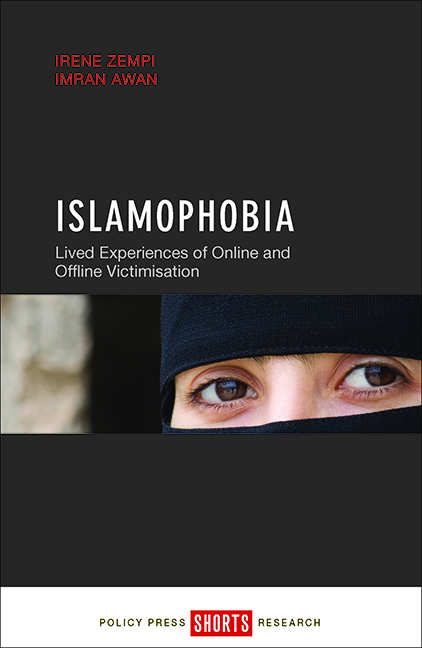Book contents
four - Nature and extent of online and offline Islamophobia
Published online by Cambridge University Press: 05 April 2022
Summary
The terrorist attacks in Paris, Tunisia and Woolwich have led to a significant increase in Islamophobic hostility, which has culminated in a rise in reprisal attacks against Muslim communities. Typically, these attacks happen in street-based Islamophobic hostility; nevertheless, an increase in online Islamophobia has resulted in a debate about the nature of online and offline Islamophobia, and the relationship between the two. Muslims, particularly those with a ‘visible’ Muslim identity, suffer Islamophobic intimidation, abuse and threats of violence both online and offline. Thus, for victims, whether ‘visibly’ Muslim or not, it is difficult to isolate the online threats from the intimidation, violence and abuse that they suffer offline. Rather, there is a continuity of Islamophobic hostility in both the cyber and in the ‘real’ world. Against this background, this chapter discusses the nature of online and offline anti-Muslim hostility.
Online Islamophobic hostility
In a post 9/11 and 7/7 climate, Islamophobic hostility has increased significantly (Weller et al., 2001; Commission on British Muslims and Islamophobia, 2004; McGhee, 2005; Githens-Mazer and Lambert, 2010). In 2013, Tell MAMA found that 74 per cent of online Islamophobic incidents had been reported to them (Feldman et al., 2013). A steady increase in Islamophobic hostility is further reinforced by data that shows that between May 2013 and February 2014, there were 734 reported cases of Islamophobic abuse, and of these, 599 were incidents of online abuse and threats, while the others were offline attacks such as violence, threats and assaults (Lancashire Telegraph, 2014).
The murder of Lee Rigby in Woolwich in May 2013 and the terrorist attacks in Paris and Tunisia in 2015, the actions of ISIS and wider international and regional events, have fuelled the growth of Islamophobic hostility on social media, as well as in the streets of Britain. For example, the recent Rotherham child sexual exploitation scandal in the UK and the activities of Islamic State militants, such as the murder of British aid worker David Haines in September 2014, have perpetuated Islamophobic sentiments and ‘legitimised’ Islamophobic attacks both online and offline (Dodd and Williams, 2014). For example, after the Paris shooting in January 2015, the #KillAllMuslims hashtag was ‘trending’ in the UK and was accompanied by a number of direct threats made targeting Muslim communities such as ‘blowing up a mosque’ and ‘shooting a Muslim for fun’.
- Type
- Chapter
- Information
- IslamophobiaLived Experiences of Online and Offline Victimisation, pp. 43 - 54Publisher: Bristol University PressPrint publication year: 2016



